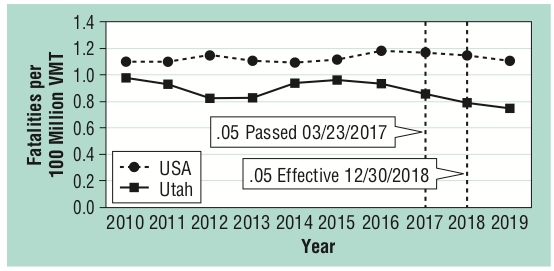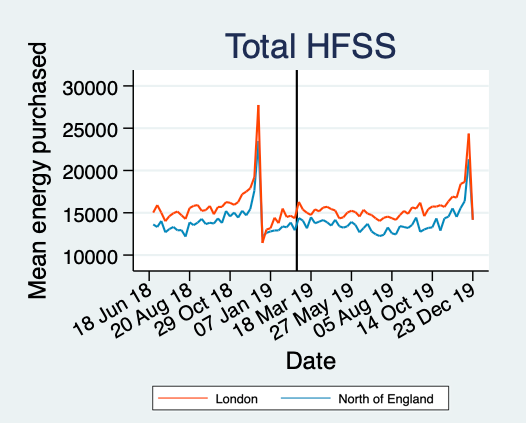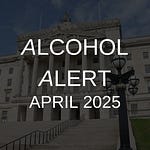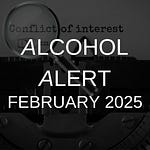Hello and welcome to the Alcohol Alert, brought to you by The Institute of Alcohol Studies.
In this edition:
Sugar content in wine bottles ranges from 0 to 15 teaspoons of sugar 🎵 Podcast feature 🎵
House of Lords debates alcohol labelling and advertising 🎵 Podcast feature 🎵
European Parliament ‘waters down’ alcohol labelling recommendations
Alcohol-related hospital stays fall in Scotland during pandemic
Government inaction on leading risk factors driving ill health
Alcohol industry lobbies via the World Trade Organization
Harmful commodity industry messaging creates doubt
Utah’s lower drink drive limit saves lives
TFL’s ban on HFSS ads is successful and paves the way for other ad bans
Man in recovery launches campaign to move alcohol aisle away from checkout
Alcohol Toolkit Study update
We hope you enjoy our roundup of stories below: please feel free to share. Thank you.
IAS Events
There’s still time to register for our final sustainability event on Wednesday 2 March at 10:00-11:30 GMT, where we will be discussing ‘Alcohol & Human Rights’ with:
Chair: Professor Leslie London, University of Cape Town
Olivier van Beemen, Investigative journalist - discussing his book Heineken in Africa
Dr Sarah Hill, The University of Sydney School of Public Health - presenting on gender and health inequality
Professor Amandine Garde, University of Liverpool Law School - looking at how human rights litigation can be used as a control policy
IAS Blogs
To read blogs click here.
Sugar content in wine bottles ranges from 0 to 15 teaspoons of sugar
Research by the Alcohol Health Alliance, Alcohol Focus Scotland and Alcohol Change UK has found that bottles of the UK’s most popular wine contain a huge range of sugar, with the highest being enough to reach your recommended daily limit.
The charity sent 30 bottles of wine (red, white, rosé, fruit, and sparkling wine) to an independent laboratory to test the sugar content. 15 of the bottles tested had 0-1 teaspoons of sugar, and were all red or white wines. Conversely the bottles that were generally weaker in alcohol content – predominantly the rosé, fruit, and sparkling wines – had far higher sugar content, with the most sugary having the equivalent of 15 teaspoons of sugar.
The Government guidelines recommend no more than 30g of free sugars a day, meaning a drinker can reach that limit with only two medium-sized glasses of wine.
None of the bottles had nutritional information on labels and calorie content was only on a fifth of the bottles.
Highlighting the “absurd” situation that means non-alcoholic products have to have more labelling information than alcoholic products, Professor Sir Ian Gilmore said:
“The Government must publish its planned consultation on alcohol labelling without further delay – which we have been waiting for since 2020. As well as calorie labelling and nutritional information, we need prominent health warnings and the UK Chief Medical Officers’ low-risk weekly drinking guidelines on labels. Studies suggest that this could help reduce alcohol harm by increasing knowledge of the health risks and prompting behaviour change.”
In this month’s podcast we spoke to Alison Douglas, Chief Executive of Alcohol Focus Scotland, about the study.
House of Lords debates alcohol labelling and advertising
On a related note, the House of Lords debated the Health and Care Bill this month, with Baroness Finlay of Llandaff announcing a probing amendment* which would require the Government to publish a report on labelling that would consider certain mandatory labelling requirements, such as the CMO guidelines, cancer warnings, and full ingredients and nutritional information.
In the same session Baroness Finlay also sought an amendment that would make the Government consult on calling alcohol a ‘less healthy product’ and therefore subject to the same advertising restrictions that HFSS foods will soon be.
Although many peers supported Baroness Finlay, Lord Lansley – former Health Secretary 2010-2012 – said it was misplaced to treat alcohol like tobacco, which he felt these amendments would do. He argued that the alcohol marketing codes have made a great difference, including contributing to a reduction in children drinking, and that we should work with the junk food and alcohol industries as they’re not like tobacco where there’s no safe level. He said, “we deal with the food and drink industry because there are safe levels of food and drink consumption”.
It is worth noting that when Lansley was Health Secretary he enlisted PepsiCo, Kellogg's, Unilever, Mars and Diageo to help write health policy, by drafting priorities and identifying barriers.
Conservative Baroness Penn said in response that a consultation is unnecessary as the advertising restrictions are aimed at reducing exposure to children, and alcohol is already an age restricted product, furthermore “there are other measures in place that address the advertising of alcohol”. Baroness Finlay withdrew the amendments.

In this month’s podcast we also spoke to Baroness Finlay regarding labelling of alcoholic products and next steps for Parliament. Finlay told us that:
“If the Government doesn’t come forward with a date for the consultation we will have to push it to a vote and we have to defeat the Government and get it through, as the population deserves to know what is in the products they drink.”
*A probing amendment means there’s no intention of the amendment being carried, but instead is used as an opportunity to discuss a particular topic
European Parliament ‘waters down’ alcohol labelling recommendations
After ‘fierce lobbying’ from the alcohol industry, Members of the European Parliament voted to ‘water down’ labelling recommendations. Instead of warning that any drinking can increase the risk of cancer, alcohol warning labels should only caution against excessive consumption and advise moderate drinking.
MEP Dolors Montserrat, a former Spanish health minister, said they had stopped “the attempt to criminalise cava, wine and beer. We reject the abusive consumption of alcohol, which is harmful to health, and we defend the moderate consumption of wine and our well-known Mediterranean diet”.
The resolution is non-binding but could guide new rules from the European Commission, such as those due in 2023 on labelling of alcoholic drinks and possible tax revisions to discourage consumption.
The initial resolution had also called for a ban on sports sponsorship by alcoholic drinks companies, but the revised text instead said that the ban should only apply to events that were mainly attended by minors.
Alcohol-related hospital stays fall in Scotland during pandemic
Between April 2020 and March 2021 alcohol-related hospital stays in Scotland fell by 10% on the previous period, with Public Health Scotland saying this is likely due to Covid preventing people from accessing necessary treatment.
The rate dropped from 681 per 100,000 to 614. There were 35,124 stays in total, with the majority treated in acute hospitals. Men were 2.3 times more likely than women to be admitted for alcohol-related reasons, and people in deprived areas were 7 times more likely than those in least deprived areas: 968 compared to 144 per 100,000.
Public Health Scotland also published an analysis of the latest data on alcohol sales and harms during the pandemic, which shows that while hospital stays fell, rates of alcohol-specific deaths increased – mainly due to increases in deaths in men and those aged 45-64. Alcohol sales were 9% lower in 2020 compared to 2017-2019 average and 16% lower in 2021.
Alison Douglas, chief executive of Alcohol Focus Scotland, said:
"While it is positive that overall Scots drank less during the last two years, this needs to be seen in the context of the devastating rise in deaths caused by alcohol during the same period.
"Drinking habits appear to have become polarised; some have cut down, while others - particularly heavier drinkers - have increased their drinking.”
Government inaction on leading risk factors driving ill health
The Health Foundation published a policy review on 23 February that analysed Government policy on the leading risk factors of preventable ill health: smoking, poor diet, physical inactivity and harmful alcohol use. The report highlights the lack of improvement over the past decade and that future targets will continually be missed if we continue along the same path.
The report highlights the alcohol strategy of 2012 and the Government’s almost immediate backtracking “on all such policies” announced within it. The Health Foundation is firm in its criticism of Government inaction, drawing attention to:
The report goes on to say that action to tackle harmful alcohol use “has been particularly weak” compared to control of other risk factors, with the Government avoiding effective intervention due to successful alcohol industry lobbying “against the introduction of policies to modify prices and marketing”.
“In relation to both alcohol and food policy, governments have tended to avoid more deterrence-based, interventionist approaches. Instead, they have often trusted those responsible for producing harmful products to help improve public health voluntarily – regardless of possible conflicts of interest.”
The report concludes that “Some of the biggest immediate gains could be made by implementing price-based policies, taxes and regulations designed to decrease affordability of unhealthy food and drink, and increase access to healthier options.”
The following demonstrates the policy inaction, particularly policies under the responsibility of the Home Office.
The Health Foundation: Summary of policy initiatives on alcohol 2012-2021
Alcohol industry lobbies via the World Trade Organization
A study by the London School of Economics has found that the alcohol industry has influence over the World Trade Organization (WTO), with WTO members using industry arguments to stall alcohol policy.
The researchers analysed a decade of WTO member statements on ten alcohol labelling policies proposed by various countries. Over 55% of the statements featured industry arguments, such as:
Reframing the nature and causes of alcohol-related problems
Promoting alternative policies such as information campaigns
Questioning the evidence
And emphasising wider economic costs of mandatory labelling policies.
WTO members raising or subject to discussions on health warning labelling proposals at the TBT Committee meetings, 2010–19
Arrows indicate statements raised by a member (left) to the corresponding member to whom the statement was directed (right). Arrow width corresponds to the number of statements raised.
The authors concluded that because many of the arguments were industry arguments but few stated that they were, “Increased transparency about vested interests might be needed to overcome industry influence”.
Read our blog by Dr Pepita Barlow on the study.
Harmful commodity industry messaging creates doubt
A new study looked at the use of “alternative causation” arguments by manufacturers of harmful products, and its impact on public understanding. The industries analysed were the alcohol, tobacco, fossil fuel and sweetened drinks industries.
The study found that:
“Across all industries, exposure to industry-sponsored messages led to greater reported uncertainty or false certainty about risk, compared to non-industry messages.”
This excellent 6 minute video explains the study findings and implications:
Utah’s lower drink drive limit saves lives
At the very end of 2018 the US state of Utah became the first, and as yet only, state to reduce its drink driving limit from 80mg of alcohol per 100ml of blood, to 50mg.
As a reference, England and Wales have a limit of 80mg, which is the highest limit in Europe. Most other European countries have a limit of 50mg, including Scotland.
The US’ Department of Transportation released a study at the end of February that evaluated the new limit and has found it led to a decrease in traffic deaths and more drivers arranging for alternative transport.
Fatalities dropped by 19.8% in 2019, the first year it was reduced, compared to a 5.6% drop across the rest of the US. And 22% of people said they’d changed their behaviour when the law came in.
Fatalities per 100 Million vehicle miles travelled (VMT)
The study also found none of the negative economic impacts predicted occurred and there wasn’t a sharp rise in those arrested over the limit, suggesting people were adapting to the new law instead.
TFL’s ban on HFSS ads is successful and paves the way for other ad bans
In February 2019, advertising of high fat, salt and sugar (HFSS) foods was restricted on the London transport network. A study by the London School of Hygiene and Tropical Medicine (LSHTM) evaluated the impact of the ban.
The study found that calories purchased were 6.7% lower in the London households evaluated compared to the control households in the North of England. Energy from chocolate and confectionary purchases was 19.4% lower in London.
Professor Steven Cummings of LSHTM said the study offers “a potentially effective intervention in other important public health policy areas such as the regulation of alcohol and gambling advertising”.
The London Mayor’s office said that companies that previously advertised HFSS products were now advertising healthier options:
“This shift has not only transformed the types of food and drink being advertised, but through engagement with the industry, TfL’s commercial media revenue actually increased by £2.3m during the first year of the policy.”
Man in recovery launches campaign to move alcohol aisle away from checkout
A petition launched by a man in recovery for alcohol use disorder is asking supermarkets to move alcohol aisles away from checkouts to support those in recovery.
Matthew Penn stopped drinking in May 2020 and has said one of the biggest obstacles to recovery was queuing along the alcohol aisle, which he said felt like a “ticking time bomb”.
Mr Penn runs an online support group and said:
“Every single person I speak to on my page says one of their biggest problems is going into shops. It can be so easily avoided. You’d think if you can cover up cigarettes then surely you could cover up alcohol.”
IAS’ Dr Alison Giles said:
“Strategically-placed alcohol in supermarkets is designed to increase purchasing and consumption, which subsequently leads to an increase in harm. To support those in recovery and reduce the cost of alcohol harm to society, a simple first step for supermarkets would be to move alcohol away from checkouts.”
Dr Jyotsna Vohra, director of policy and public affairs at the Royal Society for Public Health, said the Government should incentivise retailers by considering business rate reductions where they show they are taking health seriously by improving layouts.
Alcohol Toolkit Study: update
The monthly data collected is from English households and began in March 2014. Each month involves a new representative sample of approximately 1,700 adults aged 16 and over.
See more data on the project website here.
Prevalence of increasing and higher risk drinking (AUDIT)
Increasing and higher risk drinking defined as those scoring >7 AUDIT. A-C1: Professional to clerical occupation C2-E: Manual occupation
Currently trying to restrict consumption
A-C1: Professional to clerical occupation C2-E: Manual occupation; Question: Are you currently trying to restrict your alcohol consumption e.g. by drinking less, choosing lower strength alcohol or using smaller glasses? Are you currently trying to restrict your alcohol consumption e.g. by drinking less, choosing lower strength alcohol or using smaller glasses?
All past-year attempts to cut down or stop
Question: How many attempts to restrict your alcohol consumption have you made in the last 12 months (e.g. by drinking less, choosing lower strength alcohol or using smaller glasses)? Please include all attempts you have made in the last 12 months, whether or not they were successful, AND any attempt that you are currently making.
The UK Alcohol Alert (incorporating Alliance News) is designed and produced by The Institute of Alcohol Studies. Please click the image below to visit our website and find out more about us and what we do, or the ‘Contact us’ button. Thank you.























